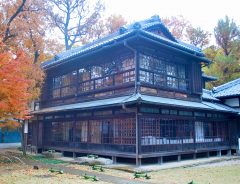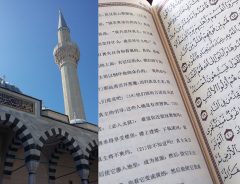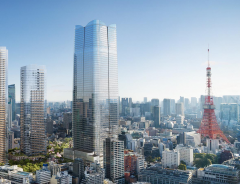
Source: Irina Gelbukh (CC BY-SA 3.0)
Waseda El Dorado: a fabulist extravaganza among Tokyo’s bland modern buildings
- Tags:
- Architecture / Von Jour Caux / Waseda El Dorado
Related Article
-

Kengo Kuma Designed “Delis Yokohama Building” Offers Dining Options And A New Landmark To Yokohama Station’s West Exit
-

The Edo-Tokyo Open-Air Architectural Museum
-

Japanese bento boxes and architecture meet in brilliant and charming designs
-

Tokyo Camii: Japan’s largest mosque is an oasis of calm in the big city
-

Japanese Pet Food Center Is Shaped Like A Giant Dachshund
-

New Tokyo Skyscraper Will Be Tallest Building in Japan Beating Out Osaka’s Abeno Harukas


Walking the streets of Tokyo, you can’t help but wonder what was going through the minds of the architects responsible for its modern buildings – not much, by the looks. With some very honourable exceptions, the city is made of a series of fragile-looking boxes, as non-descript as they are expendable.
So the sight of the El Dorado building, a stone’s throw from the main gate of Waseda University, comes as a blessed relief. The frame of the building is conventional enough, but the exterior is decorated with curving wrought-iron balconies in the shape of lily pads, and a wealth of ceramic figures decorated with tattoo-like designs. Walk inside the lobby, through an elaborate wrought iron gateway and you come to a giant hand pointing down from a ceiling of stained glass.
Photo by George Lloyd
This is the fruit of a fecund mind – or rather, minds, for Waseda El Dorado was created by a ‘troupe’ of master craftsmen, including sculptors, ceramicists, plaster moulders and fresco painters, in 1983. Their leader is the architect Von Jour Caux, who calls himself “a master architect and a proficient artisan,” and is still going strong at the age of 86.
Von Jour Caux | Photo by George Lloyd
Von Caux says that most of Tokyo’s modern buildings are like the fake food on display outside the city’s restaurants: “clean, uniformly shaped and flavourless.” As an adolescent, he watched a grim, practical and sterile city being built on the ashes of the old, without any of its charm.
He studied architecture at Waseda University and in 1956, attended a seminar by Professor Kenji Imai, who was a champion of the great Catalan architect Antoni Gaudi. Gaudi’s Sagrada Familia cathedral and Guell Park have become icons, drawing millions of tourists to Barcelona every year. Von Caux was inspired by Gaudi’s thinking, working methods, and architectural style, which celebrated craftsmanship over functionality.
Photo by George Lloyd
“My mission is umarekawari: the rebirth of something that died,” he told the Japan Times back in 1992. Despite a relative scarcity of resources, traditional Japan possessed an extraordinarily rich culture. Early Japanophiles like Ernest Fenellosa and Edward Morse were deeply impressed that a whole civilization could be created from such humble materials as paper, wood and clay. But the impact of modernisation during the Meiji era and wholesale destruction World War Two killed off several generations of craftsmen.
Photo by George Lloyd
While Von’s love of craftsmanship signals a return to traditional Japanese building techniques, the substance of his ideas owes more to Sigmund Freud and Carl Jung than to traditional designs. “My work is more about dreams; it begins at a deeper level,” he says.
Photo by George Lloyd
He is also inspired by Hinduism and esoteric Buddhism. It was Buddhism that inspired him to change his name to Von Jour Caux in 1974. Pronounced ‘bon-juko,’ Von means ‘Brahma’, Jour means ‘cause for joy,’ and Caux means ‘rope.’ The rope, dangling “between this world and the next,” has shamanistic connotations, he says.
Photo by George Lloyd
Von was born Toshiro Tanaka in Asakusa, Tokyo in 1934. He grew up in the old geisha quarter of Kagurazaka, a hillside neighbourhood of narrow alleys where a child's imagination could blossom. “I was immersed in Edo culture. Bishamon temple and the local shrines were my playgrounds,” he recalls.
Von first witnessed “the fragility of so-called reality,” when American bombers dropped incendiary bombs over Tokyo one night in 1945 and Kagurazaka went up in flames. “I poured water over my head and, holding my aunt's hand, I raced between the walls of fire. When we reached safety, I was completely dry. Inochi - a person's life - is suspended on a slender rope,” he says.
Photo by George Lloyd
His embrace of surrealistic architecture was late in coming. Like many of his peers, he started out with an interest in the clean lines and prim functionality of the International Style pioneered by Mies van der Rohe. In 1962, he travelled penniless to Chicago in search of the man himself. Though he did not study under the modernist leader, he studied painting, sculpture, and arts and crafts at Chicago’s School of Art Institute. Later, he landed a more prosaic job as a bathroom and kitchen designer for House and Garden magazine.
He stayed in the U.S. until 1964. Thereafter, he returned to Tokyo and established Von Architects, going on to design a wide variety of houses, apartment buildings, offices and resorts. It was this immersion in the day to day life of a working architect that caused him to throw off the shackles of convention in 1974 and pursue a more idiosyncratic approach.
Photo by George Lloyd
But reviving Antoni Gaudi's approach to designing buildings was far from easy. Most of Von’s projects have been for low to middle-income housing, privately developed but financed through the public housing lending authority. That has meant tight fiscal restraints. The Catalan’s traditionalism and revival of comatose European craftsmanship were all very well but applying them was beyond the budget of most of Von’s clients.
Photo by George Lloyd
Lacking the patronage by powerful families and the Catholic Church that allowed Gaudi to experiment with expensive decorative elements, he had to compromise and become more inventive. He had some materials, like terracotta roof tiles, imported from Europe, but most were produced in Japan, where his troupe of craftsmen adapted industrial methods to keep costs down. For example, he was able to reproduce the sculpted stonework that adorns so many European buildings by pouring concrete into carefully created moulds.
Von is proud to say that his team always stayed within budget and met their deadlines. But ultimately, the only way they were able to realise their visions was for all concerned to work for next to nothing – a thought worth bearing in mind next time you pass what is probably Tokyo’s most extravagant, otherworldly piece of architecture.
Waseda El Dorado is a four-minute walk from Waseda station, which is on the Tozai line.